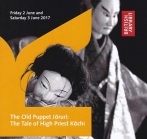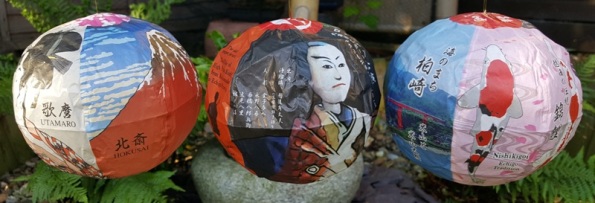Review: The Old Jōruri Puppet Play ‘The Tale Of The High Priest Kōchi’
Performance was held on 2nd and 3rd June 2017 at the British Library.
 The evening, attended by around 250 people, opened with a welcome from Mana Takatori, the Director General of the Japan Foundation, and Hamish Todd, the Head of East Asian Collections at the British Library. Then Professor Torigoe Bunzō described how the manuscript was discovered and how valuable it is given that it is the only extant original copy.
The evening, attended by around 250 people, opened with a welcome from Mana Takatori, the Director General of the Japan Foundation, and Hamish Todd, the Head of East Asian Collections at the British Library. Then Professor Torigoe Bunzō described how the manuscript was discovered and how valuable it is given that it is the only extant original copy.
In 1962, when at the time he was a Professor at Waseda University, Torigoe Bunzō was teaching at Cambridge University and whilst on a visit to London he was informed that there was a Japanese book of unknown origin at the British Museum Library.
Upon investigation he discovered that it was the only surviving original copy of a play, the fictionalised biographical tale of ‘The Life of the High Priest Kōchi from Kashiwazaki in *Echigo Province’ which tells the story of the Buddhist monk Kōchi Hōin who became a sokushinbutsu (a monk who practices austerity to the point of death and self-mummification) who’s mummified remains, the oldest in Japan, are kept at Saishōji-ji Temple in Nagaoka, Niigata Prefecture (*Echigo is the old name for Niigata Prefecture).
Professor Donald Keene then gave a talk on the origins of Jōruri and the play, which was written as Kojōruri, Old Jōruri, a traditional style of Japanese puppet theatre which preceded the Bunraku plays of Chikamatsu Monzaemon which were performed between 1685 and 1715. After a brief break Professor of Japanese Studies at SOAS, Andrew Gerstle, gave a synopsis of the play which is made up of six acts. It was mentioned that culturally the spirits of the characters inhabit their respective puppets for the duration of the play.
Acts II and III of the play were performed with the shamisen player and reciter Echigo Kakutayū, Donald Keene’s adopted son, and the Sado based Bunya puppeteer Nishihashi Hachirōbei, and four other puppeteers.

It’s an unsophisticated but powerful story which was probably used as a tool for preaching to temple congregations.
Act II – The father of the main character Onuma Hirotomo, who is living a life of debauchery, is going to punish him for fighting. Hirotomo disguises his servant as himself and the servant rides off on his horse. Yanagi-no-Mae, the wife of Hirotomo, who is with her first son Chiyokawa, mistakes the servant for her husband and tries to stop the horse by grabbing its tail. The servant draws a sword and kills Yanagi-no-Mae who dies hating the man she thinks is her husband. Just before she dies she gives birth to her second son who is kidnapped by a wolf (which later in the play turns out to be the Gongen Yahiko Daimyōjin* of Echigo). Hirotomo is filled with remorse and, after arranging for his son Chiyokawa to be adopted, decides to undertake a pilgrimage to Koyasan, Mt. Koya. (*Gongen – Shinto Kami manifestation of a Buddhist Deity, Daimyōjin – Great Shining Deity.)

Act III – Hirotomo spends a night at a temple in Kashiwazaki. He meets a priest there who receives him into the Shingon priesthood and gives him the name Kōchi (Great Wisdom – 弘知). The priest then reveals to Kōchi that he is Saint Kōbō Daishi who then disappears. Kōchi then meets the ghost of his dead wife who learns what happened and they are reconciled. Then he meets a woman who attempts to seduce him. He does not succumb and the woman transforms into a demon from the sixth shade of hell which attacks him. Kōchi throws his rosary at the demon which turns into the sword of the Buddha. The demon is defeated and retreats. The sword turns back into a rosary and Kōchi resumes his journey to Koyasan.

Kōchi Hōin meets a demon on his way to Mt. Koya – British Library Digitised manuscript
His journey culminates in him becoming an enlightened being and he undertakes the process of self-mummification dying as a soshukinbutsu at the age of 66 and is enshrined in Saishōji-ji Temple as the reincarnation of the Buddhist Saint Shōtoku Taishi, a manifestation of Bosatsu Kannon, Goddess of Mercy. His mummy became famous in Japan as a result of Kyozan Santo’s 1837/1841 book, ‘Snow Country Tales’ (Hokuetsu Seppu) according to which the Priest Kōchi was from the Kodama Clan from Yamakuwa village in Shimoosa. He spent some time at Mount Koya and then travelled back to his home village where he resided at Rengedera Temple in Oura. He visited Echigo and then settled in Iwasaka east of Saishōji Temple of Kaiunzan near Nozumi village (Nozomi in local dialect), Mishima County where he built a hermit’s hut where on the 2nd November 1371 he ‘entered nirvana’. His death poem reads:
Should people ask
who is the master of Iwasaka
– the soughing wind through the pines
of an ink painting
His mummy was one of the twenty-four wonders of Echigo. Only his face is visible, his eyes closed as if in sleep.

‘Snow Country Tales’ (Hokuetsu Seppu), Suzuki Bokushi, 1837/1841. Illustration by Santō Kyōden (山東 京伝)
After the performance Nishihashi Hachirōbei gave a demonstration of puppeteering and how the puppets are constructed during which the extent to which he is emotionally engaged with puppets and puppeteering became obvious.
It was a very special event and a wonderful afternoon only made possible by the dedication of those involved.
Photographs of the performance (Japanese website)
http://www.asahi.com/articles/ASK634R1MK63UHBI01B.html

Front cover and first page (right to left) – British Library Digitised manuscript
The book was written anonymously and printed in 1685, the same year it was performed at the Sekkyō-za Theatre in Nihonbashi in Edo presented by the chanter Edo Magoshirō. It was part of the collection of Engelbert Kaempfer (1651-1716), a German naturalist, explorer and physician, who lived on the island of Dejima, the Dutch trading post and enclave, in Nagasaki between 1690-1692 from where he visited Edo and Tokugawa Tsunayoshi, the ‘Dog’ Shōgun, on two occasions. When he left in November 1692 he took with him a large collection seeds, artefacts and manuscripts, the latter of which were purchased by Sir Hans Sloane, the founder of the British Museum, who brought them to England and deposited them there.
In 1973, along with the rest of Kaempfer’s books, it was transferred to the newly established British Library. The play was published in Japan in 1966 and then, through the encouragement of Professor Donald Keene, it was performed by Echigo Kakutayū and Nishihashi Hachirōbei along with the newly established Echigo Saruhachi-za troupe at the Industrial Cultural Hall in Kashiwazaki City in Niigata Prefecture in May 2009, and in October 2010 it was performed at the Hamarikyu Asahi Hall in Tōkyō. https://blogs.yahoo.co.jp/ric05jpn/51083142.html
In 2016 a talk was given by Donald Keene on the play and its rediscovery at Portland State University entitled ‘A Journey through Sin, Redemption, Miracles and High Adventure: The Tale of the High Priest Kōchi’. Tsuruzawa Asazō V (aka Echigo Kakutayu) played the shamisen and sang a recital of Act III.
The performances at the British Library were presented in collaboration with the Japan Foundation and produced by The London Performance Implementation Committee for: The Old Puppet Jōruri: The Tale of High Priest Kōchi.

British Library Digitised manuscript
British Library African and Asian Studies blog
http://blogs.bl.uk/asian-and-african/2017/05/japanese-puppet-play-revived.html
Digitised version
http://www.bl.uk/manuscripts/FullDisplay.aspx?ref=Or_75_g_23/1

London Performance Memorial celebratory Japanese paper balloons
Biographies

Donald Keene (photo Japan Times)
http://ealac.columbia.edu/portfolio-items/donald-keene/

Torigoe Bunzō (鳥越文蔵) (photo Tokyo Newspaper Forum)
Born in Nagasaki Prefecture in 1931. Graduated from Waseda University Faculty Graduate School of Letters, Arts and Sciences. Served as a professor at Waseda University. Published the historical critique of Kabuki ‘Genroku Kabuki Kō’ in 1992 winning the Geijutsu Senshō Monbu Daijin-shō (Ministry of Education, Culture, Sports, Science and Technology Minister’s Prize for the Arts). In 1997 he received the Shijuhōshō (Medal of Honour with Purple Ribbon) for services to the Arts. In 1999 after he retired he concentrated on research into traditional theatre focusing on the jōruri of Chikamatsu Monzaemon, and along with Umewaka Rokurō Gensho compiled the ‘Umewaka Minoru Nikki’ (Diary of Umewaka Minoru – the Noh actor of late Edo early Meiji period) Professor Emeritus at Waseda University and Former Director of Waseda University Tsubouchi Memorial Theatre Museum where he managed the Museum’s modernisation. He was the first President of the Kabuki Society.

Echigo Kakutayū (越後角太夫) (photo Ricardo Watanabe)
Born in Niigata in 1950 he is the adopted son of Donald Keene known as Seiki Keene. Graduated from Tokyo University of Foreign Studies (Major in French). Played shamisen with the National Bunraku Theatre for 25 years under the stage name of “Tsurusawa Asazo V.” Today his activities include composition of early Joruri tunes, story-singing and playing shamisen.

Nishihashi Hachirobei (西橋八郎兵衛)
Sado-based Bunya puppeteer. Lives in Sado City. Major in Theatrical Studies at University. In June 1970 began working with Yoshida Minosuke as a puppeteer with the stage name Yoshida Minoshi until March 1979 when he resigned and moved to Sado City where he joined the ‘Osakiza’ Bunya Puppet Company after which he joined the ‘Masaakiza’ Bunya Puppet Company where he still works. In 1995 he launched the ningyō jōruri ‘Saruhachiza’ Company. From 2006 he began recruiting local community based Shamisen players. From April 2011 he began working with the reciter of sutra based ballads accompanied by the shamisen Watanabe Hachitayū (渡部八太夫) to continue to develop the potential of puppet plays.
Reviewer Profile:
Trevor Skingle was born and lives in London where he works in the field of Humanitarian Disaster Relief. He is a Japanophile and his hobbies are Kabuki, painting and drawing and learning Japanese.
Related Posts:
Book Review: Japanese Plays – Classic Noh, Kyogen And Kabuki Works
Spring and New Year Kabuki in Tōkyō – Part Two National Theatre of Japan and Asakusa Kōkaidō
Theatre Review: Ninagawa Company – ‘Hamlet’ (Hamuretto) By William Shakespeare
Theatre Review: ‘Kaidan Chibusa no Enoki’ (The Ghost Tale Of The Wet Nurse Tree)
-
August 17, 2017 at 3:41 pmBook Review: Living Buddhas: The Self Mummified Monks Of Yamagata, Japan By Ken Jeremiah | Diverse Japan
-
September 12, 2017 at 2:52 pmTV Review: Tokyo Trial Four-Part Mini-Series | Diverse Japan










